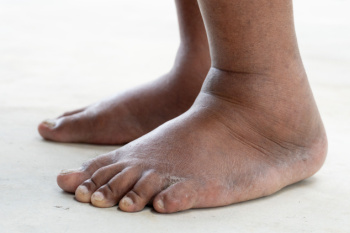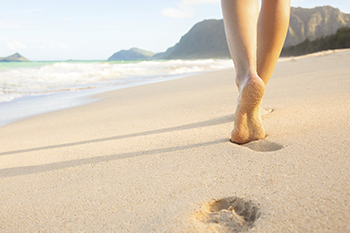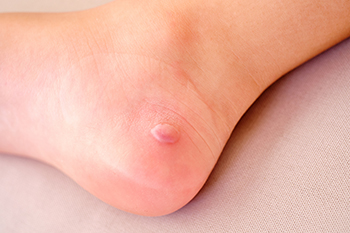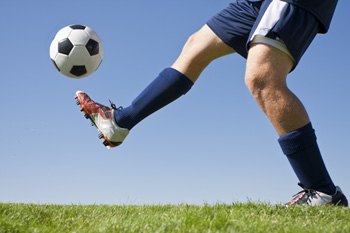Items filtered by date: June 2024
Factors and Management of Swollen Feet
 Swelling of the feet, also known as edema, is a condition that results from an abnormal accumulation of fluid in the tissues of the feet and ankles. This swelling can be caused by various factors, including standing or sitting for long periods, pregnancy, or obesity. Injury, or underlying health conditions like heart disease or kidney problems are other risk factors. Swollen feet can be uncomfortable, may restrict mobility, and can make daily tasks difficult to complete. Often, simple changes in regimen, such as elevating the feet, wearing compression socks, staying hydrated, and engaging in regular exercise may reduce the amount of swelling in the feet. If swelling persists or is accompanied by other concerning symptoms, it is suggested to seek evaluation and treatment from a podiatrist to ensure proper management and prevent complications.
Swelling of the feet, also known as edema, is a condition that results from an abnormal accumulation of fluid in the tissues of the feet and ankles. This swelling can be caused by various factors, including standing or sitting for long periods, pregnancy, or obesity. Injury, or underlying health conditions like heart disease or kidney problems are other risk factors. Swollen feet can be uncomfortable, may restrict mobility, and can make daily tasks difficult to complete. Often, simple changes in regimen, such as elevating the feet, wearing compression socks, staying hydrated, and engaging in regular exercise may reduce the amount of swelling in the feet. If swelling persists or is accompanied by other concerning symptoms, it is suggested to seek evaluation and treatment from a podiatrist to ensure proper management and prevent complications.
Swollen feet can be a sign of an underlying condition. If you have any concerns, contact Gabrielle Clark, DPM of LA Feet Foot & Ankle Center, Inc. Our doctor can provide the care you need to keep you pain-free and on your feet.
Swollen feet are a common ailment among pregnant women and people who stand or sit for extended periods. Aging may increase the possibility of swollen feet and patients who are obese often notice when their feet are swelling too. There may be medical reasons why swollen feet occur:
- Phlebitis - A condition that causes the veins to become inflamed and can also cause leg pain.
- Liver disease - This may lead to low blood levels of albumin which is a protein. This can cause fluid in the blood to pass into the tissues and several areas of the body can become swollen.
- Heart failure - When the heart doesn’t pump properly the blood that is normally pumped back to the heart can pool in the veins of the legs causing swollen feet.
- Kidney disease - One of the main functions of the kidneys is releasing excess fluid in the body. This type of condition can make it difficult for the kidneys to function properly, and as a result the feet may become swollen.
- Deep-vein thrombosis (DVT)- This is a serious condition where blood clots form in the veins of the legs. They can block the return of blood from the legs to the heart which may cause the feet to swell. It is important to be treated by a podiatrist if this condition is present.
Swollen feet can also be caused by bone and tendon conditions, including fractures, arthritis, and tendinitis. Additionally, there may be skin and toenail conditions and an infection may cause the feet to swell. Patients who take medicine to treat high blood pressure may be prone to getting swollen feet.
Many patients elevate their feet to help relieve the swelling and this is generally a temporary remedy. When a podiatrist is consulted the reason behind the swelling can be uncovered and subsequently treated.
If you have any questions please feel free to contact our offices located in New Orleans, and Metairie, LA . We offer the newest diagnostic tools and technology to treat your foot and ankle needs.
Taking Care of Feet While Traveling
 Traveling often leads to tired and achy feet due to prolonged periods of walking, standing, or sitting. These activities can cause swelling, discomfort, and fatigue in the feet, especially when confined to tight spaces like airplane cabins or car seats. The lack of movement restricts blood flow, causing fluid to pool in the lower extremities. This can result in a sensation of heaviness, throbbing, or even pain. To soothe tired and achy feet while traveling, take regular breaks to stretch and walk around, promoting better circulation. Elevate your feet when possible to reduce swelling. Wearing comfortable, supportive shoes and compression socks can also alleviate discomfort. Gentle foot massages can help reduce inflammation and provide relief. Additionally, staying hydrated and avoiding excessive salt intake can also prevent fluid retention. If foot pain persists or becomes severe, it is suggested that you visit a podiatrist for a thorough evaluation and personalized advice.
Traveling often leads to tired and achy feet due to prolonged periods of walking, standing, or sitting. These activities can cause swelling, discomfort, and fatigue in the feet, especially when confined to tight spaces like airplane cabins or car seats. The lack of movement restricts blood flow, causing fluid to pool in the lower extremities. This can result in a sensation of heaviness, throbbing, or even pain. To soothe tired and achy feet while traveling, take regular breaks to stretch and walk around, promoting better circulation. Elevate your feet when possible to reduce swelling. Wearing comfortable, supportive shoes and compression socks can also alleviate discomfort. Gentle foot massages can help reduce inflammation and provide relief. Additionally, staying hydrated and avoiding excessive salt intake can also prevent fluid retention. If foot pain persists or becomes severe, it is suggested that you visit a podiatrist for a thorough evaluation and personalized advice.
Foot Pain
Foot pain can be extremely painful and debilitating. If you have a foot pain, consult with Gabrielle Clark, DPM from LA Feet Foot & Ankle Center, Inc. Our doctor will assess your condition and provide you with quality foot and ankle treatment.
Causes
Foot pain is a very broad condition that could be caused by one or more ailments. The most common include:
- Bunions
- Hammertoes
- Plantar Fasciitis
- Bone Spurs
- Corns
- Tarsal Tunnel Syndrome
- Ingrown Toenails
- Arthritis (such as Gout, Rheumatoid, and Osteoarthritis)
- Flat Feet
- Injury (from stress fractures, broken toe, foot, ankle, Achilles tendon ruptures, and sprains)
- And more
Diagnosis
To figure out the cause of foot pain, podiatrists utilize several different methods. This can range from simple visual inspections and sensation tests to X-rays and MRI scans. Prior medical history, family medical history, and any recent physical traumatic events will all be taken into consideration for a proper diagnosis.
Treatment
Treatment depends upon the cause of the foot pain. Whether it is resting, staying off the foot, or having surgery; podiatrists have a number of treatment options available for foot pain.
If you have any questions, please feel free to contact our offices located in New Orleans, and Metairie, LA . We offer the newest diagnostic and treatment technologies for all your foot care needs.
Children's Foot Blisters and Prevention Tips

Foot blisters in children often stem from friction caused by wearing ill-fitting shoes or excessive moisture buildup. Improperly sized footwear can rub against delicate skin, leading to painful blisters. Prolonged periods of activity, especially in hot or humid conditions, can also exacerbate the problem by increasing sweat production, which softens the skin and heightens friction. Additionally, wearing socks made from non-breathable materials can contribute to moisture accumulation, creating a conducive environment for blister formation. To prevent these discomforts, it is vital to ensure that children wear properly fitted shoes with ample room for their growing feet. Opting for moisture-wicking socks made from breathable fabrics can also help keep feet dry and reduce friction. Encouraging breaks during physical activities and teaching children to recognize early signs of discomfort can prompt timely adjustments, preventing blisters from worsening. If your child has a foot blister that has become infected, or if recurring blisters develop, it is suggested that you consult a podiatrist who can offer effective treatment and prevention tips.
Blisters may appear as a single bubble or in a cluster. They can cause a lot of pain and may be filled with pus, blood, or watery serum. If your feet are hurting, contact Gabrielle Clark, DPM of LA Feet Foot & Ankle Center, Inc. Our doctor can provide the care you need to keep you pain-free and on your feet.
Foot Blisters
Foot blisters are often the result of friction. This happens due to the constant rubbing from shoes, which can lead to pain.
What Are Foot Blisters?
A foot blister is a small fluid-filled pocket that forms on the upper-most layer of the skin. Blisters are filled with clear fluid and can lead to blood drainage or pus if the area becomes infected.
Symptoms
(Blister symptoms may vary depending on what is causing them)
- Bubble of skin filled with fluid
- Redness
- Moderate to severe pain
- Itching
Prevention & Treatment
In order to prevent blisters, you should be sure to wear comfortable shoes with socks that cushion your feet and absorb sweat. Breaking a blister open may increase your chances of developing an infection. However, if your blister breaks, you should wash the area with soap and water immediately and then apply a bandage to the affected area. If your blisters cause severe pain it is important that you call your podiatrist right away.
If you have any questions, please feel free to contact our offices located in New Orleans, and Metairie, LA . We offer the newest diagnostic and treatment technologies for all your foot care needs.
Plantar Warts Can Be Treated!
Common Foot Injuries in Soccer

Soccer players frequently encounter foot injuries due to the sport’s high physical demands. Foot blisters are common, starting as irritated skin and developing into fluid-filled bubbles from the friction inside the shoes. Ankle sprains, the most common soccer injury, occur from twisting or impact, leading to ligament stretching or tearing. Wearing tight shoes often cause toenail injuries, and can lead to blood forming under the nail, loose nails, or nails falling off. Turf toe, a painful sprain of the big toe joint, occurs from sudden jamming movements, especially on artificial turf, and necessitates rest and immobilization. Plantar fasciitis causes heel pain, resulting from inflammation of the tissue that connects the heel to the toes, and is considered an overuse injury. Achilles tendonitis affects the back of the heel and can be caused by overuse, inadequate warm-ups, or wearing improper footwear. Foot fractures and stress fractures often result from direct impacts, acute twisting, or repetitive stress during play. If you have sustained a foot or ankle injury while playing soccer, it is suggested that you schedule an appointment with a podiatrist for a diagnosis and treatment.
Ankle and foot injuries are common among athletes and in many sports. They can be caused by several problems and may be potentially serious. If you are feeling pain or think you were injured in a sporting event or when exercising, consult with Gabrielle Clark, DPM from LA Feet Foot & Ankle Center, Inc. Our doctor will assess your condition and provide you with quality foot and ankle treatment.
Common Injuries
The most common injuries that occur in sporting activities include:
- Achilles Tendonitis
- Achilles Tendon Rupture
- Ankle Sprains
- Broken Foot
- Plantar Fasciitis
- Stress Fractures
- Turf Toe
Symptoms
Symptoms vary depending upon the injury and in some cases, there may be no symptoms at all. However, in most cases, some form of symptom is experienced. Pain, aching, burning, bruising, tenderness, tightness or stiffness, sensation loss, difficulty moving, and swelling are the most common symptoms.
Treatment
Just as symptoms vary depending upon the injury, so do treatment options. A common treatment method is known as the RICE method. This method involves rest, applying ice, compression and elevating the afflicted foot or ankle. If the injury appears to be more serious, surgery might be required, such as arthroscopic or reconstructive surgery. Lastly, rehabilitation or therapy might be needed to gain full functionality in the afflicted area. Any discomfort experienced by an athlete must be evaluated by a licensed, reputable medical professional.
If you have any questions, please feel free to contact our offices located in New Orleans, and Metairie, LA . We offer the newest diagnostic and treatment technologies for all your foot care needs.

